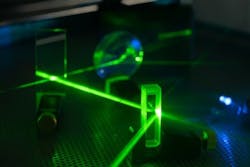Learning Optics with Austin: Lesson 8 – Prisms and Total Internal Reflection
Besides lenses and mirrors, prisms are another group of common optical elements. White light that enters a prism leaves as many different colors due to the different refractive indexes of each color’s wavelength (a topic that will be covered in further depth in the next post). Besides refracting white light, prisms have another useful property that can result in 100% reflectivity (no exaggeration!). A reminder (from post #3) that reflectivity is the percentage of light that is reflected off a surface. Even with the most expensive coatings and smoothest surfaces, even mirrors cannot match the 100% reflectivity characteristic of prisms. How is it that prisms can surpass mirrors in reflectivity?
Total Internal Reflection Diagram
Total internal reflection is the property of prisms resulting in 100% reflectivity. While the conditions of total internal reflection are relatively straightforward, the math behind the phenomenon is a bit more involved. The diagram above shows two mediums, glass and air in which light must travel through. We set n1 to be the refractive index of glass and n2 to be the refractive index of air. A reminder (from post #4) that the higher the refractive index, the greater the “bending” of light. The first condition of total internal refraction is that n1 > n2, of which is the case in the diagram. The second condition is that the incidence angle (I1) must be greater than the critical angle (I0). The critical angle is the angle at which total internal reflection occurs, which in the diagram, would be I4. Brace yourselves for a little math!
Refractive Index Equation
Using the relationship sin(I1) / sin(I2) = n2 / n1 mentioned in post #4 (which also happens to be Snell’s Law: n1 sin(I1) = n2 sin(I2) rearranged), we can see from the diagram that I2 can at most be 90 degrees. This is the point in which the refracted ray of light is parallel to the surface. The I1 when I2 is 90 degrees is the critical angle at which total internal reflection occurs. Since I2 must always be less than or equal to 90 degrees (think about why to check your understanding), the most that sin(I2) could be is 1 (since I2 cannot be negative, the least it could be is 0 and sin(0) = 0 while sin(90o) = 1). We can thus rewrite sin(I1) / sin(I2) = n2 / n1 as sin(I1) = n2 / n1 where I1 is the critical angle that can be calculated from sin-1(n2 / n1).
Total Internal Reflection
After all this math, you might be wondering- why should I care? Remember that the incidence angle being greater than the critical angle is the second condition of total internal reflection. This property is what gives prisms 100% reflectivity, which is a feat even mirrors cannot achieve. By taking advantage of this property, you can save a lot of money and simplify the design of the optical system you are designing!

Austin from Shanghai Optics Inc
Hello! My name is Austin and I am the host for this blog. I graduated from Rutgers in May 2021 with a Bachelor’s degree in Statistics-Mathematics and History. I interned during the summer of 2021 at Shanghai Optics working on data cleaning and analysis. I was later offered to work full-time starting in September. While my initial role was in data analytics, I realized that my knowledge of the company’s products was quite shallow as a key skill for any well-trained data analyst is to know your data. That’s how I got started on my journey in learning about optics.
I found physics interesting but challenging in high school. I did not particularly enjoy classical physics and a seminar in quantum mechanics flew over my head in college. As I see first-hand how our optics works in different applications, I’m quickly beginning to realize that Photonics has the potential to shape the present and the future. Because of my newfound enthusiasm, management took notice and I am fortunate enough to begin a Physics/Photonics class sponsored by Shanghai Optics in the fall of 2021. This blog is part of my experience in taking the class and sharing with you all the wealth of knowledge I’m acquiring!
Aside from optics, some of my personal interests include studying history and going on hikes. Both activities are great opportunities to talk with other people so feel free to ask me any questions on my personal interests or the materials I post!
